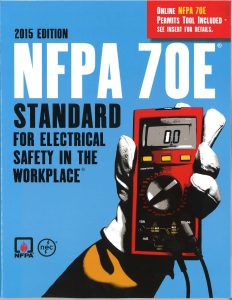 Both the Occupational Safety and Health Administration (OSHA) and the National Fire Protection Association (NFPA) have written standards and regulations that build on one another and help keep workers safe from electrical hazards in the workplace.
Both the Occupational Safety and Health Administration (OSHA) and the National Fire Protection Association (NFPA) have written standards and regulations that build on one another and help keep workers safe from electrical hazards in the workplace.
The NFPA 70E is a national consensus safety standard published by the NFPA primarily to assist OSHA in preparing electrical safety standards. Federal OSHA has not incorporated it into the Code of Federal Regulations.
OSHA bases its electrical safety standards on the comprehensive information found in NFPA 70E. It focuses on protecting people and identifies requirements that are considered necessary to provide a workplace free of electrical hazards. The OSHA regulations and NFPA standards work so well together it’s been said that OSHA provides the “shall” while NFPA provides the “how.”
For example, OSHA mandates that all services to electrical equipment be done in a de-energized state. Working live (or working in an energized state) can only be done under special circumstances. NFPA 70E defines those special circumstances and sets rigid electrical safety limits on voltage exposures, work zone boundary requirements, and necessary personal protective equipment.
In 2015, the NFPA released the tenth edition of the 70E standard for electrical safety in the workplace based on the 2014 NFPA 70 (NEC) Code. The previous edition was published in 2012 and there are significant differences between the two.
The 2015 edition reflects a major shift in how electrical risk is evaluated. In previous editions, risk was established by performing a shock and arc flash analysis that would quantify the risk. Moving forward, the new edition streamlines the requirements for arc and shock protection and outlines revised program requirements with emphasis on risk assessment—now called a flash risk assessment. This means the potential for harm is now based on the combination of severity and the likelihood of failure. The flash risk assessment addresses hierarchy of controls, such as electrical installation (engineering controls) and work practices.
Below are highlights of the remaining changes from the 2012 to the 2015 edition.
1. Safety-related maintenance requirements were added to clarify that training and auditing are equally important.
2. All references to bare-hand work were removed.
3. A new definition of “energized electrical work permit” was added and the definition of “qualified person” was revised.
4. Prohibited approach boundary was deleted.
5. An electrical safety program must now include elements that consider condition of maintenance.
6. Audits of field work must be performed at intervals not to exceed one year.
7. The location, sizing, and application of temporary protective grounding equipment must be identified.
8. New requirements clarifying where normal operation of electric equipment is permitted were added.
9. Clarification was added that either the incident energy analysis method or arc flash PPE category method be used on the same piece of equipment for the selection of PPE, but not both.
10. Labels must be updated when the arc flash hazard risk assessment identifies a change that renders the existing label inaccurate.
11. Additional text now provides the user with a boundary to the existing requirements in 130.6(D).
12. A new “yes or no” format task-based table was added to determine when arc flash PPE is required.*
13. A new arc flash PPE category/equipment-based table was added for determining the arc flash PPE category.
14. Hazard/risk category 0 from Table 130.7(C)(16) will now be referred to as PPE category.
15. The criterion for employees to use insulated tools or handling equipment has been changed from the limited approach boundary to restricted approach boundary.
16. Barricades cannot be placed closer than the limited approach boundary.
17. An electrician must perform a risk assessment if the likelihood of contacting energized electrical lines or parts exists.
18. There are clarifications that the equipment owner or designated representative is responsible for maintenance of the electrical equipment and documentation.
19. New maintenance program for test instruments must include functional verification.
20. Risk assessment must be performed prior to any work on a battery system.
*NFPA added the new task-based table (referenced in #12 above) to utilize a simple yes-or-no format to determine if arc flash PPE is required. If yes, the new equipment-based table (referenced in #13 above) is then used to determine the flash PPE category (previously known as hazard risk category) and arc flash boundary. Finally, to determine PPE needed, the newly modified category table referenced in #14 above is used.
Nickle Safety – It’s How We’re Wired
Mike Anderson, CHST
Safety Director





